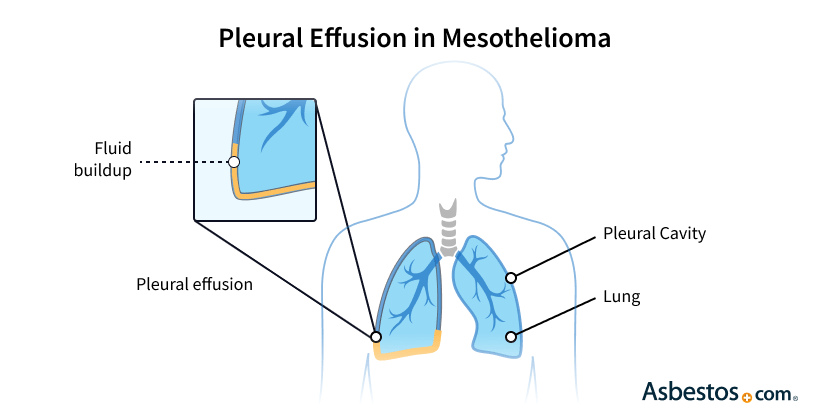Pleural Effusion and Mesothelioma
Pleural effusion is extra fluid between the lungs and chest wall. Most mesothelioma patients experience this symptom. It can cause chest pain and trouble breathing. Draining the fluid is often one of the first treatments.
What Is Pleural Effusion?
Pleural effusion associated with mesothelioma is fluid build up between the chest wall and the lungs, also known as “water on the lungs.” This is a common problem for people with mesothelioma. When fluid collects in the pleural cavity, it can make breathing painful and more difficult.
Key Facts About Pleural Effusion
- More than 1.5 million people are diagnosed with a pleural effusion every year.
- Pleural effusion is common in mesothelioma, with up to 90% of patients experiencing it.
- This fluid buildup sometimes develops before any other signs of mesothelioma.
Learn about your diagnosis, top doctors and how to pay for treatment in our free mesothelioma guide.
Get Your GuidePleural effusions often happen early in peoples’ pleural mesothelioma journeys. Dr. Jeffrey Velotta, thoracic surgeon at Kaiser Permanente Oakland Medical Center, tells us, “A pleural effusion is fluid that forms from the pleural lining, secreting usually as a blockage or as a result of mesothelioma in the pleural lining.”
Types of Pleural Effusion
The main types of pleural effusions are grouped based on how the fluid forms. One group includes fluids that collect when pressure changes or low protein levels in the blood cause leaking. These are called transudates. The other group includes fluids that develop when illness or injury inflames or damages the lung lining. These are called exudates.
Sometimes, the fluid also contains blood (hemothorax), lymph fluid (chylothorax) or pus (empyema). Doctors test the fluid to identify its type and cause, so they can choose the best treatment.
Pleural Effusion Types
- Bloody effusion: Blood in the pleura, also known as hemothorax
- Cancer-causing effusion: Malignant effusion made of cancer cells
- Cholesterol effusion: Milky substance with cholesterol crystals
- Fatty effusion: Made of lymphatic fluid with excess fat
- Infection-causing effusions: Pus with bacteria or viruses
- Non-cancer-causing effusions: Clear or pale substance from heart failure or infections
- Protein-depleted (transudative): Thin, low-protein, clear or pale fluid linked to heart or liver issues
- Protein-rich (exudative): Thick, high-protein cloudy fluid containing tumor cells
Some types of pleural effusion are associated with pleural thickening, and some more than others. Effusions involving intense inflammation or cancers like mesothelioma can cause pleural thickening. Malignant pleural effusions often cause inflammation and scarring that lead to this thickening.
What Causes Pleural Effusion?
Common causes of pleural effusion include irritation from bacteria, viruses and cancer cells like mesothelioma cells. Infections and cancerous cells create irritation in the lining around the lungs. This irritation promotes excess fluid production and collection in the thoracic cavity. As mesothelioma tumors spread over this lining, called the pleura, they can also block lymphatic vessels or blood flow, leading to fluid accumulation.
Causes of Pleural Effusion
- Alcoholism
- Asbestos exposure
- Autoimmune disorders like lupus
- Bacterial infections like pneumonia
- Blood clots in the lung (e.g. pulmonary embolism)
- Cancer treatments, like chemotherapy and radiation
- Congestive heart failure
- Liver failure or cirrhosis
- Lung infections
- Mesothelioma or other asbestos-related cancer
- Thoracic cancers, like lung or breast cancer
- Trauma or surgery
When fluid drainage is blocked, excess fluid builds up around the lungs. This happens because the normal balance between fluid production and removal is disrupted. This causes fluid to accumulate faster than it can be cleared. Over time, this buildup can compress the lungs and make it harder to breathe comfortably.

Learn about your diagnosis, top doctors and how to pay for treatment in our updated 2025 guide.
Get Your Free GuideMesothelioma & Pleural Effusion
Pleural effusion isn’t just a hallmark symptom of mesothelioma but also a window into how the tumor disrupts normal lung function. The disease lowers important proteins in the blood, such as albumin, which normally keep fluid inside blood vessels. When these protein levels drop, fluid leaks out and collects around the lungs.
This extra fluid can make breathing harder and cause discomfort. Mesothelioma survivor Michael Bederman tells us he experienced shortness of breath from pleural effusions for a year and had them drained every few months. When he requested a biopsy, doctors confirmed the cause was pleural mesothelioma.
Michael Bederman says, “Everything with me will work out for the best. I don’t sit around feeling sorry for myself. Not at all. I’m grateful for every day and for all the help I’ve received. I look for the good in everything.”

What Are the Symptoms of Pleural Effusions?
Symptoms of mesothelioma pleural effusion manifest as shortness of breath, cough or chest pain as the increasing fluid constricts the lungs and makes breathing increasingly difficult. Over time, difficulty breathing leads to other symptoms such as fatigue and weight loss.
The more fluid that exists, the more symptoms present themselves, making breathing more challenging. However, a 2025 study in the Journal of Clinical Medicine found that the volume of an effusion didn’t impact survival.
Common Pleural Effusion Symptoms
- Chest pain
- Cough
- Decreased breath sounds
- Fatigue
- Fever
- Pain in the shoulder
- Problems lying down
- Shortness of breath
- Sudden weight loss
Consult a doctor if you have any symptoms. Doctors can drain the fluid and provide oxygen and medication for comfort. Without treatment, pleural effusions can become infected or cause lung collapse.
How Do Doctors Diagnose Pleural Effusions?
Doctors usually confirm a pleural effusion diagnosis with imaging scans. X-rays, CT scans or ultrasounds will confirm the presence of fluid buildup and show doctors where the effusion is located.
Tools Used to Diagnose Pleural Effusion
- Blood tests
- Chest physical assessment
- Chest X-ray
- CT scan
- Fluid drainage and tests (thoracentesis)
- Pleura biopsy
- Ultrasound
To determine the specific type of pleural effusion, pleural fluid is drained with a procedure called thoracentesis. The fluid is then examined. Its contents will confirm if there are atypical or cancer cells present. The sooner doctors diagnose the condition and determine the cause, the sooner they can develop an appropriate treatment plan.
How Can Pleural Effusions Help Diagnose Mesothelioma?
In mesothelioma, pleural effusions house cancerous cells. Specialized procedures called cytology tests look for cancer cells in fluid, aiding in mesothelioma diagnosis. This is particularly important for those with a history of asbestos exposure.
Patient Advocate Snehal Smart, M.D., tells us, “The fluid is drained, and a cytology exam, which is the study of the cells, is performed. Any presence of mesothelial cancer cells would indicate a diagnosis of mesothelioma.”
A 2025 study in Radiology and Oncology reported that the presence of a protein called Fibulin-3 in a pleural effusion could be a strong indicator or biomarker of mesothelioma. The study showed that higher fibulin-3 levels were present in people with advanced or more aggressive disease, but the test didn’t necessarily predict how long they would live.
How Is Pleural Effusion Treated?
Treatment for pleural effusion includes draining the fluid for symptom relief and restoring breathing function. Doctors may also recommend surgeries for the prevention of future occurrences. Many people with mesothelioma-related pleural effusions have multiple treatments, especially in later stages.
For example, someone may have a thoracentesis and then a surgical procedure called pleurodesis if the fluid comes back. Each treatment is done based on the cause of the fluid and severity.
Pleural Effusion Treatments
- Analgesics for pain relief
- Chest tube to evacuate fluid
- Diuretics (to remove excess fluid from heart failure)
- Pleural catheter for extended drainage
- Pleurodesis surgery to obliterate the pleural space
- Pleurectomy surgery, which removes the pleura and tumors
- Steroids to decrease inflammation
- Thoracentesis, using a needle to drain the fluid
A 2025 report in Pulmonary Therapy discussed how the intrapleural catheter provides a conduit into the pleural space and can be particularly helpful for mesothelioma treatment. Doctors can use it to direct treatment locally to the pleura, where the primary source of cancer often lies.
What Is the Prognosis for Pleural Effusion?
The outlook for pleural effusion depends on its cause. Because the prognosis for mesothelioma is generally poor, the outlook for effusions linked to this aggressive cancer is also generally poor. Pleural effusions indicate advanced disease and tumor effects disrupting lung function.
If heart or liver failure is the cause, the prognosis relies on your overall health and how available and effective treatments are for you. Early treatment can assist people with symptoms. Even in advanced cases, draining fluid affords comfort and improved respiratory function. Support groups like our Facebook support group, as well as clinical trials can offer hope for better outcomes.
Common Questions About Pleural Effusions
- Can I reduce my risk of pleural effusion?
-
Yes, preventing or treating the underlying cause can help you reduce the risk of pleural effusions. For example, avoiding asbestos exposure as much as possible, treating any infections promptly and managing heart or liver dysfunction can reduce the risk of fluid buildup. Cancer prevention and healthy habits for the heart and lungs, such as a balanced diet, regular exercise and quitting smoking, are also effective ways to prevent pleural effusions.
- How long can you live with pleural effusion?
-
Life expectancy with pleural effusion depends on the cause and your overall health. For mesothelioma patients, survival time depends on the management of the pleural effusion and the cancer’s progression. Supportive care can improve comfort and quality of life. It includes symptom management and treatments.
- Can pleural effusion come back after treatment?
-
Yes, pleural effusion can return after treatment. This is common in chronic conditions like mesothelioma. Some patients may need ongoing treatments, like a catheter for at-home drainage. An indwelling catheter can manage fluid buildup and ease symptoms over time.
- How long does it take for pleural effusion to resolve?
-
The time for pleural effusion to resolve depends on the underlying cause and the associated treatment. Some cases may improve within weeks with treatment. Others, especially mesothelioma-related effusions, may need long-term care.
- Can pleural effusion be prevented in mesothelioma patients?
-
Preventing pleural effusion in mesothelioma is tough. However, proactive care can reduce symptoms. Chemotherapy might reduce fluid, shrinking tumors. Also, pleurodesis that seals the pleural space can stop extra fluid from building up.





